In the late summer/fall of 1989, I picked up Fr.
Khoat at the Cincinnati airport. He was making his first visit to
Cincinnati, Ohio by arrangement with myself and Mr. Gary Giuffre of St.
Jude’s Shrine in Houston, Texas. With our fifth child just having been
born, we did not have an available guest room in our house anymore, so I
was to drop Fr. Khoat at the house of one of our friends, the Burns
Family, where he was kindly welcomed to stay for his short visit of
several days. He was going to meet several people while in town, and say
Mass for those interested. (Fr. Khoat had always remained loyal to
saying the traditional Latin Mass.)
Fr. Khoat had ended up as one of the “boat people” who fled Vietnam as
the Communists overran the southern portion of that country in 1975. He
had been the assistant to one of the Bishops of Vietnam in the years
preceding the fall of Saigon. He had been in charge of getting out the
diocesan newspaper for the Bishop.
At the time I was working on getting the first issue of All These Things newspaper/magazine published. Fr. Khoat gave me his advice on how to make periodicals interesting. (All These Things
was to be, and has been in the 8 issues we have published since 1990, a
newspaper on current events and history based on the Catholic Social
teaching of the Kingship of Christ.)
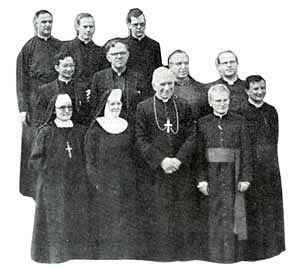
Fr. Khoat in Group Photo (he is pictured on the 2nd row, first shown, going from left to right) in 1981.
Fr.
Khoat was originally from Vietnam; a country with a historically large
Catholic population as a result of the efforts of
French Catholic missionaries throughout the centuries. "Cardinal Siri"
[Pope Gregory XVII] who was fluent in French and Fr. Khoat spoke to each
other in the
French language at their private meetings in Rome, Italy 1988.
(Note: the Editor of (TCW) was told by a SSPX spokesman a Mr. James Vogel, that
Fr. Khoat never was a part of the SSPX and never serviced their (SSPX's) chapels. Father Khoat is
pictured with Archbishop Lefebvre
(seven years before Lefebvre’s Theologically schismatic consecrations) and other Traditional
priests and nuns, in 1981. 1st row, left to right—Sisters Mary Raphael and Mary Grace, of Queen of Angels, Dickinson;
Archbishop Lefebvre, Father Philipe Demouliere of Our Lady of Grace in Kenner, Louisiana; Fr. Regis Babinet, new pastor in El
Paso; 2nd row, left to right: Fr. Khoat, Texas Philip Stark and Fr. CarlPul-vermacher of Queen of Angels;
Fr. Terence Finnegan, Pastor of Our Lady of Sorrows in Phoenix; last row, left to right: Fr. Hector Bolduc, District
Superior; Fr. Joseph Collins, Headmaster of St. Mary's Academy in St. Mary’s,
Kansas; and Robert Mayer, seminarian from St.
Thomas Aquinas Seminary, Ridgefield, CT.)
During one of our meetings, he took a “traditionalist” Catholic
publication into his hands and said (paraphrase from memory), “See the
date on this magazine? April, 1989. It may as well say April, 1949. The
cover is a devotional piece that could have been written in the 1940s.
All the articles could have been written in the 1940s. There is nothing
on the cover about current events. There is hardly anything in the
magazine which is about anything current. To get people interested, to
make people anticipate the arrival of the publication and to look
forward to reading it, you must deal with current events as well as
historical or devotional articles.”
From my introduction to, and subsequent collaboration with, Mr. Gary
Giuffre, I had been made aware that Fr. Khoat had been sent on a mission
to try and see Joseph Cardinal Siri in the spring of 1988, and that Fr.
Khoat had related to Mr. Giuffre and others that, as Fr. Khoat
understood it, Siri had, after persistent questioning, indicated to Fr.
Khoat during a brief visit that he (Siri) was the Pope in exile.
Background to the chain of events that led to Fr. Khoat’s visit
A nun who had responded to one of my Fatima ads which had appeared in the Wanderer and The Remnant
in 1983, Sister Magdalen Therese of New York state, had called me on
the phone for the first time in August of 1988. After appropriate
introductions, Sister exclaimed with urgency, “You have to talk to Gary
Giuffre . . . Gary Giuffre.” I said, “Who’s Gary Giuffre?” Sister
responded, “He’s working on the Cardinal Siri project . . . the Cardinal
Siri project.” I asked, “Who’s Cardinal Siri?” Sister said that I had
to call Gary Giuffre. I asked her if she could summarize it. She said to
just call Gary Giuffre.
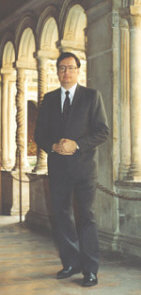
Mr. Gary Giuffre
Motivated much by the Frenchman Louis Hubert
Remy's important interview with "Cardinal Siri" that was published in
English in December 1987; Mr. Giuffre then, wrote a number of
compelling articles in the late 1980s
which have become known around the world, and some articles since that time.
I wrote his number down, and put it on my
computer desk in our living room. I was in the middle of many projects
on top of making a living in that month, including helping a friend who
was running for state representative in Ohio to put on radio ads
exposing then Senator Howard Metzenbaum’s statement made in a 1986
public speech, and which had been carried in the American Israelite
newspaper, “Do not let the forces of evil takeover and make this a
Christian America.”
Gary’s number sat on a small piece of paper on my computer desk for the next 3 months.
On November 17, 1988, I was cleaning my desk off (a disconcerting event
which circumstances force upon me about every six months) when I came
across the little paper I had written Gary Giuffre’s phone number on,
next to the number was the phrase “Cardinal Siri project.” I stopped and
dialed the phone. It was about 10 o’clock at night. It turned out that
Gary and I talked for 5 hours in that first conversation. About 30
minutes into the call, after I had introduced myself and we got
sidetracked talking about many aspects of current events and 20th
century history, I returned to the reason I had called.
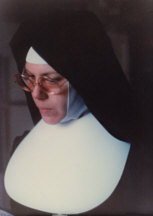
Sister Magdalen Therese
(Sisters of the Most Holy Name of Mary)
This Traditional Nun put Jim Condit Jr. in contact with Gary Giuffre, an individual who whose
has done much investigation on the suppressed Pontificate of Pope Gregory XVII ("Cardinal Siri")“So
what is the Cardinal Siri project which Sister Magdalen Therese had
called me about?” I asked. “It appears that Siri was elected Pope in
1963 before Paul VI,” Gary began.
(All conversations in this testimony are paraphrased from my best recollections.)
Before Gary could say anything else, it was as if someone had turned on a
light in my mind that illuminated a thousand corridors for as far as
the eye could see. In a flash I thought, “Of course, that would explain
everything.”
Background
I had been born in 1953, had gone to St. Margaret of Cortona grade
school in the community of Madisonville, Cincinnati, Ohio from 1959 to
1967. From my family on both sides, and from my grade school teachers
and pastors, I had received a solid and orthodox Catholic start. In the
4th grade I found out I had some talent for the piano and organ, and by
the 7th grade, Fr. Wollering made me the assistant organist. My grandma,
Rose Kenney (nee Contadino) would accompany me to play low Mass every
morning at 6:30 A.M.
While there had been the creeping changes of the sixties, such as
guitars at some Masses and the altar turned around so that the priest
faced the people, the influence of Archbishops Altar and Liebold, along
with the priests of the Archdiocese of Cincinnati, prevented the
Catholic faithful from being swept up in the revolutionary fervor that
would hit St. Xavier High School like a violent tornado in the fall
1968.
In the fall of 1967, I began at St. Xavier High School, a Jesuit
institution that was ranked 28th academically among high schools in the
nation. My freshman year at St. Xavier High school was the last year
that the “old methods” were in place. This year was a continuation of
the solid Catholic atmosphere I had known (without really identifying it
as such) my whole life.
However, by the fall of 1968, the beginning of my sophomore year,
something had happened. It was as if the silent order had gone out to
harass and hide any priest who was openly remaining faithful in the
Catholic faith. Coincidentally, Fr. Boyle, the “law and order” assistant
principal during my freshman year, had gone to Vietnam to be a chaplain
to the beleaguered soldiers in the increasingly unpopular war, which we
now know was a deliberately created no-win situation for the US
soldiers.
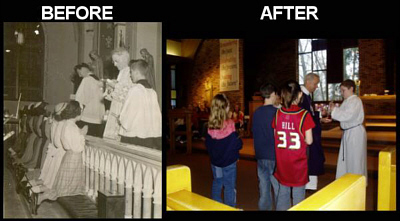
A Liberty of Perdition
Fr. Boyle’s departure turned out to be symbolic of the departure of the
traditional Jesuit atmosphere. I remember on one of my first days at St.
Xavier high, while walking down a crowded corridor as the 1200 students
changed classes, Fr. Boyle grabbed a kid in front of me by the back of
the neck. I was close enough to hear Fr. Boyle say, “One of us needs a
haircut. It’s not me. Report to my office tomorrow morning.” Fr. Boyle
then disappeared down another corridor. The kid had a little hair
peaking over his collar. By my senior year, just before school ended, I
saw a freshman coming up the stairs from the student lounge with long
hair hanging down half way to his waist. It hit me at that moment how
much the once austere and disciplined atmosphere had changed in just
three years.
The requirements for the boys to wear suit and tie to school, a
tradition at the school for at least the last several decades, if not
over a century, was ended. As stated above, the rule governing hair
length was dropped, and soon thereafter some of the students were
beginning to look like refugees from Woodstock. The sound religion books
I had known since the first grade were gone, and suddenly we were
studying comparative religions as the main focus. In my sophomore year,
the requirement for each class to go to Mass twice a week was dropped
(the chapel could only hold two of the 4 years attending the high school
at any one time). Going to mass was now an all volunteer affair, and
few volunteered.
While I did not analyze what was transpiring before my
eyes very carefully, or realize the significance of what was happening,
in retrospect I was like a man sitting on a wall. Looking to one side, I
could see the “old Church”, and looking to the other side, I could see
the “new Church” which was replacing it. The spirit was completely
different. One urged you on to climb upward and overcome your selfish
tendencies. The other, the new spirit, subtly encouraged one to
self-indulgence, laxity, and intellectual indolence.

|
St. Alphonsus Liguori: "The devil has always attempted, by means of the heretics, to deprive the world of the Mass, making them precursors of the Anti-Christ, who, before anything else, will try to abolish and will
actually abolish the Holy Sacrament of the altar, as a punishment for
the sins of men, according to the prediction of Daniel: ‘And strength
was given him against the continual sacrifice' (Dan. 8:12)."
|
The basic message became some variation on “the Church is growing up”,
“the old faith was for children, modern man is now more adult”, and “all
roads basically lead to the same faith, but we have a rich tradition in
the Roman Catholic Church.”
As a teenager loaded down with homework and all the insidious
disorientation growing up in the late sixties, I was focusing on daily
demands. I did not view myself as a “watchman on the tower”, nor did I
realize that there was a need for a watchman on the tower. I took the
easy way being offered to me, and in my mind determined that the
conception of the Faith as understood by previous generations was a
simplification. I basically lost the Faith from 1968 to 1974. If all
roads lead to the same place, why get all exercised about taking the old
rules seriously? Besides, the rules were “coming down.” Paul VI had
discontinued “no meat of Friday” a few years earlier, and now it seemed
to be beginning to “make sense.” (This was exactly the enervating and
destructive influence that was intended by those orchestrating “the
changes.”)
Throughout most of this six year period, I continued to play mass at
6:30 AM in the morning on weekdays and two low masses on Sunday at St.
Margaret of Cortona parish. The Tridentine Mass had become the New Mass,
but I continued to play the traditional hymns except when forced to
play one of the un-singable New Fangled ditties, most of which seemed to
be obsessed with the word “Zion.” Throughout this period, I determined
not to tell my parents or anyone else that I did not believe that the
Catholic Church was the one true Church anymore – why upset them? They
wouldn’t understand anyway, as they had not yet “caught the wave” – to
use an expression of the 1980s.
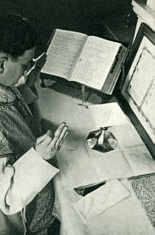
The Immemorial Tridentine Latin Mass
In 1974, for reasons not totally understood by me at the time, some
local Catholics had invited Fr. Francis Fenton of Bridgeport,
Connecticut into Cincinnati to say the Tridentine mass, which, it turned
out, had just disappeared completely from all the parishes in
Cincinnati, Ohio because “Archbishop” Bernardin had demanded that Fr.
Piepenbeier stop saying the Tridentine Mass at Old St. Mary’s a few
weeks earlier.
Someone had told the organizers of this
Tridentine Mass, -- which was to be held at the Drawbridge Inn because
there was no welcome to be found at any parish church in the area, by
order of “Archbishop” Bernardin himself, -- that I was an organist. One
of the ladies called me and asked if I would play hymns for the mass if
they brought an organ to the hotel. I said I would be glad to do so.
Afterwards, it was advertised that Fr. Fenton would give a speech. I had
been familiar with Fr. Fenton’s writings and speeches on Communism and
the forces animating Communism. I thought I was going to a political
speech. In fact, Fr. Fenton’s subject was, “The Roman Catholic Church:
its Tragedy and its Hope.” In this speech Fr. Fenton focused on the
catastrophic changes sweeping over the Catholic world since the end of
Vatican Council II. He stated that the New Mass in English was
sacrilegious due to its alterations of the very form of the consecration
of the Mass; that it was better to stay home on Sunday rather than
attend one of these “New Mass” services which violated the First
Commandment because of the prohibition against false worship.
During the talk, I was jolted to see Fr. Fenton bow his head when he
said the Holy Name of Jesus. It didn’t seem like I had seen -- or at
least hadn’t noticed -- anyone do that in the previous seven years.
My first reaction to myself was, “Do people still do that? Can people
still believe that way?” The impression insidiously communicated
throughout my high school and college years was that the “old way” was
going, going, gone.
From that day forward, I began to look back into the Church, and the crisis in the Church.
From 1974 until 1988, I had often heard this question from anguished,
concerned fellow Catholics who had stuck with the New Mass in the
parishes out of a (misguided) sense of loyalty to the Church: “We’d like
to go to the Latin Mass, too – but where’s your Pope?” (From about 1974
until sometimes in the 1980s, all Latin Masses, especially the
Tridentine Mass, was effectively banned from the parishes by the
American bishops and from almost the whole world. The one exception was
in the Vatican and some parts of Italy where the usurpers seemed to want
to keep up some appearances for the sake of the Italians, who were,
after all, on their doorstep.)
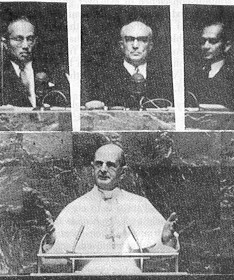
Montini [a.k.a "pope" Paul VI] pictured giving a speech
on October 4, 1965 at the United Nations
Montini in his address to the United Nations, called that godless monstrosity [The UN]
"the last, best hope of
mankind..."
Anyway, many times I had heard some variation of that question: “Where’s
your Pope?” This was a question I pushed aside, not knowing what to
make of it. I had always felt that Paul VI was a hostile force to me, to
sanity, to everything decent. Unlike many well-intentioned but
increasingly desperate older Catholics, I did not allow Paul VI’s
occasional conservative speeches and crocodile tears to distract from
the non-stop demolition operation that he was overseeing while occupying
the Chair of Peter.
Even when I was in my personal limbo and crisis of faith from 1968 to
1974, I always recognized that Paul VI was orchestrating the demolition
operation against “the old way” that was in progress within the
structures of the Church. But there he was -- wearing white in the
Vatican. So in 1974 and beyond, as I began to grope my way back to sound
and consistent thinking and practice, I just put the entire question on
hold. (Not being able to resolve this question, however, does cause a
subconscious doubting of the indefectibility of the Church, and
therefore the temptation to become demoralized and lose all faith.)
On the one hand, I felt sure we were not to
abandon the proven and sanctified traditions of the Church for the
debilitating rot that was being forced on the parishes. On the other
hand, I knew that Catholics were to obey the Pope in essential matters.
If the Mass was not an essential matter, what was? And yet those of us
attending the tridentine Mass were doing so outside of the parish
system. Varying explanations were offered, more or less satisfying, but
not compelling. I had tentatively adopted the position of the Society of
St. Pius X, which told the faithful that, in effect, we were resisting a
bad Pope. This seems reasonable, but, as I later learned, discounted
the disqualifying seriousness of the heretical and schismatic acts of
Paul VI. I just put the ultimate resolution of the whole question on
hold.
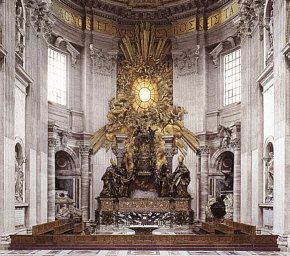
The Throne of The King of
Rome, The Pope
(St. Peter's Basilica, Rome)
Then, on that night of November 17, 1988, when I was informed that
someone had apparently been elected before Paul VI in 1963, there
finally seemed to be a convincing answer to the question of how all
these destructive changes had been introduced into the structures of the
Church: an enemy hath done this, as Holy Scripture says.
Through Gary Giuffre I had learned that, with his help and guidance, Fr.
Khoat had gone on a mission to see Cardinal Siri in April, 1988 – about
one year before Siri’s death. The purpose was to see if Siri would
confirm in a face to face conversation that he was, indeed, the long
prophesied Pope in exile, the Holy Father who “would have much to
suffer” referred to by Our Lady of Fatima.
Many of the details which I am about to
relate, I had already heard from Gary Giuffre, with one notable
exception. I will now proceed to relate the conversation which Fr. Khoat
and I had on that day in the latter part of 1989. All conversation in
quotes is a paraphrase to the best of my ability, but the essentials are
correct as to what transpired between us that day.
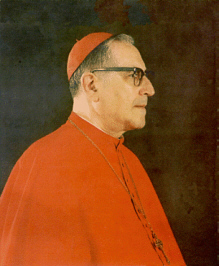
His Holiness Gregory XVII, The Suffering Pope in Exile
The publishers at (TCW) conclude, based on Fr. Khoat’s report, other
evidence, and what has transpired in the Vatican since 1958, that Siri
was indeed the long prophesied Pope in exile, and that this unlocks the
key to understanding the eclipse of the Church predicted by Our Lady of
LaSalette.
Back to my conversation with Fr. Khoat in late 1989
As
we arrived at the Burns house at about 1:30 PM in the afternoon, Mrs.
Burns invited us in, brought us some ice tea or water or pop, and left
Fr. Khoat and I in the living room while she attended to some of her
small children.
At that point, I knew that Fr. Khoat had been to see Siri, and had seen
a picture of the two of them together to prove it. (The picture was
shown in the Saturday night slide presentation given by Mr. Gary Giuffre
to a group of about 30 Catholics I had pulled together in Cincinnati,
Ohio around February, 1989 – about 7 months before Fr. Khoat came to
Cincinnati on this trip.) I wanted to hear what Father’s first hand
impressions were.
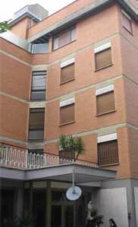
Istituto Ravasco Convent, Rome, Italy
Fr. Khoat first met with "Cardinal Siri" in a tense brief private meeting at the Istituto Ravasco Convent (located at Via Pio VIII, 28. 00165 Roma) on June 14th, 1988 A.D.
Fr. Khoat told me how he was unable to get in to see Siri in Genoa. This
mirrored the experience of a number of other people. But during his
stay in Genoa, he learned one day in a restaurant owned by friends of
Siri that Siri was in Rome, at a convent where he stayed when in the
Eternal City. Fr. Khoat quickly took a train to Rome. It turned out that
this was in the period where John Paul II was going to “canonize” the
Vietnamese martyrs, so many Vietnamese were in Rome. Father gave some
money to a few little Vietnamese kids who were playing near the convent
where Siri was staying. He asked them to go inside and find out when
Mass was the next day. Fr. Khoat showed up at the appointed time, amidst
a somewhat tense situation, and obtained a five minute meeting in
private with Siri, under the guise of getting something signed.
Father told me that once alone he said to Siri: “Are you the Pope?” Siri
denied the question several times. At this point, Fr. Khoat told me he
blurted out. “If you had done the consecration of Russia as Our Lady
requested then my Bishop would not have been killed and my country would
not have fallen to the Communists.”
According to Fr. Khoat, Siri seemed to tear up.
Khoat continued, “You are the Pope, not de facto, but de jure.” (In other words, Siri was not in control of the Vatican [de facto, or in fact], but he was by law [de jure] the rightful and true Pope.)
According to Fr. Khoat, Siri responded, “You already know it.”
Then Fr. Khoat said, “Come with me right now. I have two tickets to go to America where there are people who will help you.”
Siri replied, “That would be impossible. I cannot go. They can kill me at anytime.”
Siri told Fr. Khoat to come back at 8 PM that night when his secretary
would be gone. Fr. Khoat went back that night and also saw Siri one more
time with another *priest he brought from a nearby city.
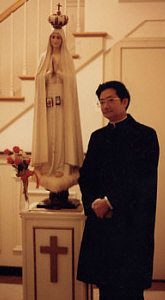
Picture of important priest Fr. Khoat next to a statue of Our Lady of Fatima "He, Pope Gregory XVII, admitted in front of me that 'He was Pope Gregory XVII'.
His (this) confirmation took place in Rome on June 14, 1988."
(Written statement of Fr. Khoat, who met with the Hidden Pontiff, His Holiness, Pope Gregory XVII)
(*Note: this other priest who Fr. Khoat brought with him on his third secret meeting with the Hidden Pope, "Siri", was Monsignor Carlo Taramasso from Santa Marinella, Roma - The Webmaster)
There is more to this story, some of which I learned a few years later.
(All of the above I had already heard, more or less, from Gary Giuffre
via phone conversation.)
Nevertheless, at this point I asked Fr. Khoat the following key
question: “Did Siri know he was Pope from 1963, or did he come to
realize in later years that the way he had been knocked off the throne
was illegitimate, and that he was in fact the rightfully elected Pope."
Without any hesitation, and with a very steady, emphatic voice, Fr.
Khoat responded, during the first few words of this response he closed
his eyes tightly and shook his head from side to side: “Oh, no, he knew
he was Pope from 1958. He was elected. He accepted. And he took the name
Gregory XVII. Go look at what happened in 1958 – this is when it all
happened.”
I then said, “So Siri was checkmated. Was he waiting for the chance to do something?”
Fr. Khoat: “Yes, he was waiting for the chance to do something.”
I said, “But the chance never came?”
Khoat: “The chance never came.”
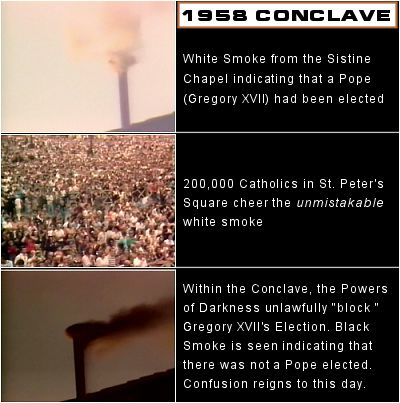
1958
Conclave - White smoke coming from the chimney of the Sistine Chapel
witnessed by 200,000 Catholics in St. Peter's Square, confirming a Pope
was elected, had accepted and had chosen a name. Only when these three
conditions were met would white smoke be sent up through the Sistine
Chapel chimney for a full five minutes.
I called Gary Giuffre that night and asked him if he had ever heard from
Fr. Khoat that the conclave that mattered was the 1958 Conclave. Gary
responded that Fr. Khoat had not told him this. Based on this
information, Gary went to the Houston Chronicle archives, and eventually
to other sources, and began to piece together the incredible happenings
at the 1958 conclave. Indeed, on October 26, 1958 white smoke had
billowed out of the Sistine chapel stovepipe as evening fell for a full
five minutes. This could only happen if a Pope had been elected, had
accepted, and had chosen a name. The Vatican radio announced that there
was a new Pope for 30 minutes as several hundred thousand people filled
St. Peter’s Square to receive the blessing of the new Pope. The Swiss
guards were ordered out of their barracks to take up their positions in
anticipation of the Pope’s imminent appearance on the balcony. And on
and on. Then suddenly, about thirty minutes after the white smoke,
indicating a new Pope had been elected, had turned back to black without
explanation, everything was halted. Two days later, on October 28th,
Cardinal Roncalli walked out on the balcony and was presented to the
world as the newly elected Pope, John XXIII. The world press cheered
wildly – and the demolition operation against the Church was underway.
The implications of Fr. Khoat’s testimony were staggering. This would
mean that a true Pope was elected, shoved aside, and replaced by an
anti-pope. This would mean that ALL the strange, disconcerting, and
destructive changes that had been imposed on the unsuspecting faithful
since 1958 were not the actions of the Church, but the actions of a
counter-church, an anti-church, -- the “counterfeit church of darkness”
foreseen by the Venerable Anna Catherine Emmerick circa 1821. This would
indicate that we are living through the period described circa 1846 by
Our Lady of LaSalette when she said, “The Church will be in eclipse.”
The Church was still there, but hidden from the view of almost the whole
world by the counterfeit church of darkness which has pulled off the
false council, Vatican II, replaced the true Mass with the sacrilegious
“New Mass”, vitiated the rite of the consecration of bishops in 1969,
replaced the sound textbooks in use throughout the Catholic world with
heretical and fluff textbooks meant to deprive Catholic children of
their birthright to the Faith, and perpetrated so many more works of
destruction.
But as the Venerable Anna Catherine Emmerick is also
quoted as saying to the Catholics trying to remain faithful who would
live through this period, “Do not lose heart; victory will be ours.”


